How Do Morphological Factors Influence the Green Nut Yield of Chinese Torreya?
Abstract
1. Background
2. Materials and Methods
2.1. Overview of the Experimental Site
2.2. Measurement or Calculation of the Morphological Traits and Green Nut Yield
2.3. Data Processing and Analysis Methods
3. Results and Analysis
3.1. Individual Differences in the Morphological Traits and Green Nut Yield of Chinese Torreya
3.2. Correlation Analysis among Morphological Traits
3.3. Relationship between Morphological Traits and Green Nut Yield
4. Discussion
5. Conclusions
Author Contributions
Funding
Data Availability Statement
Acknowledgments
Conflicts of Interest
Appendix A
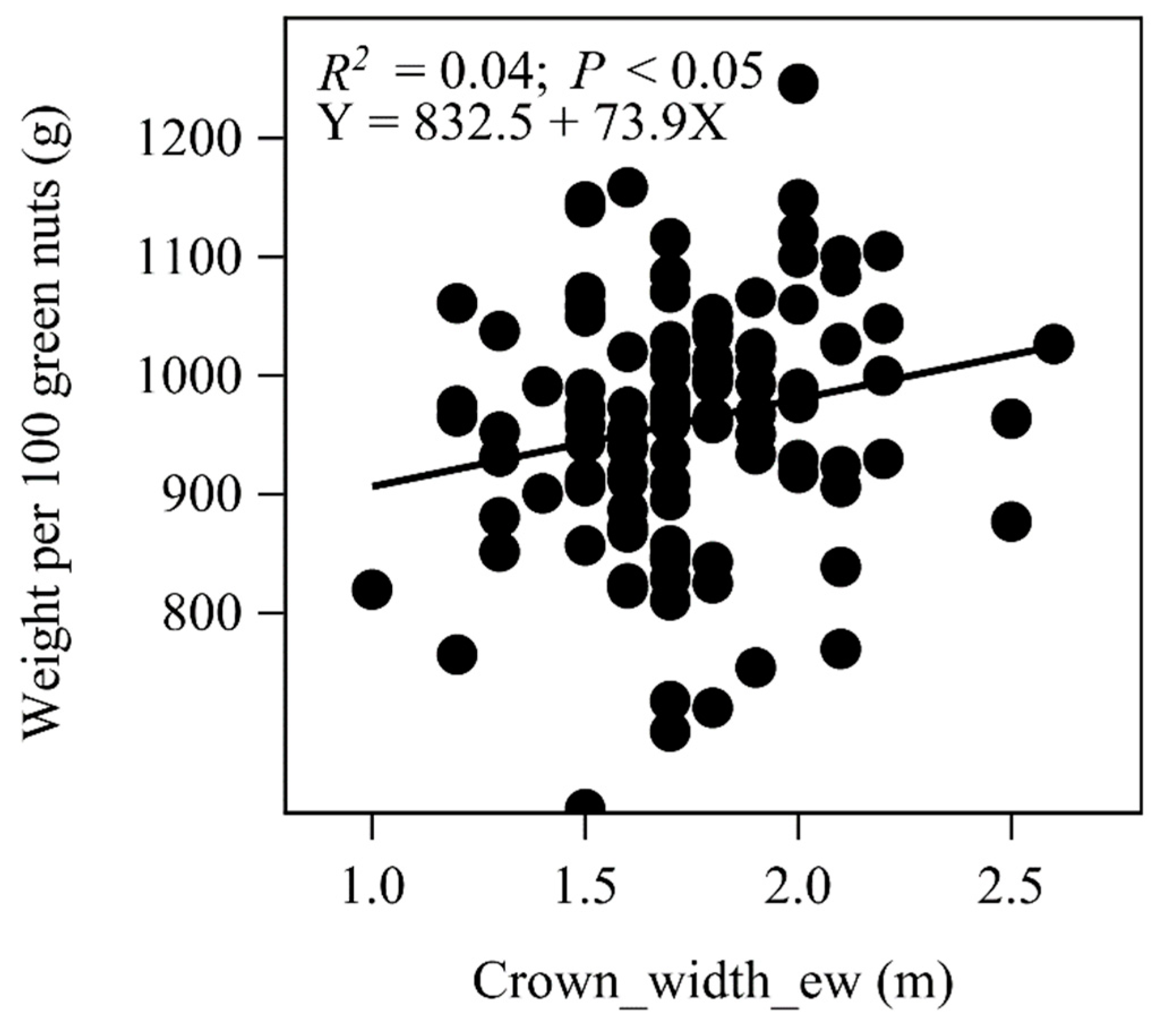
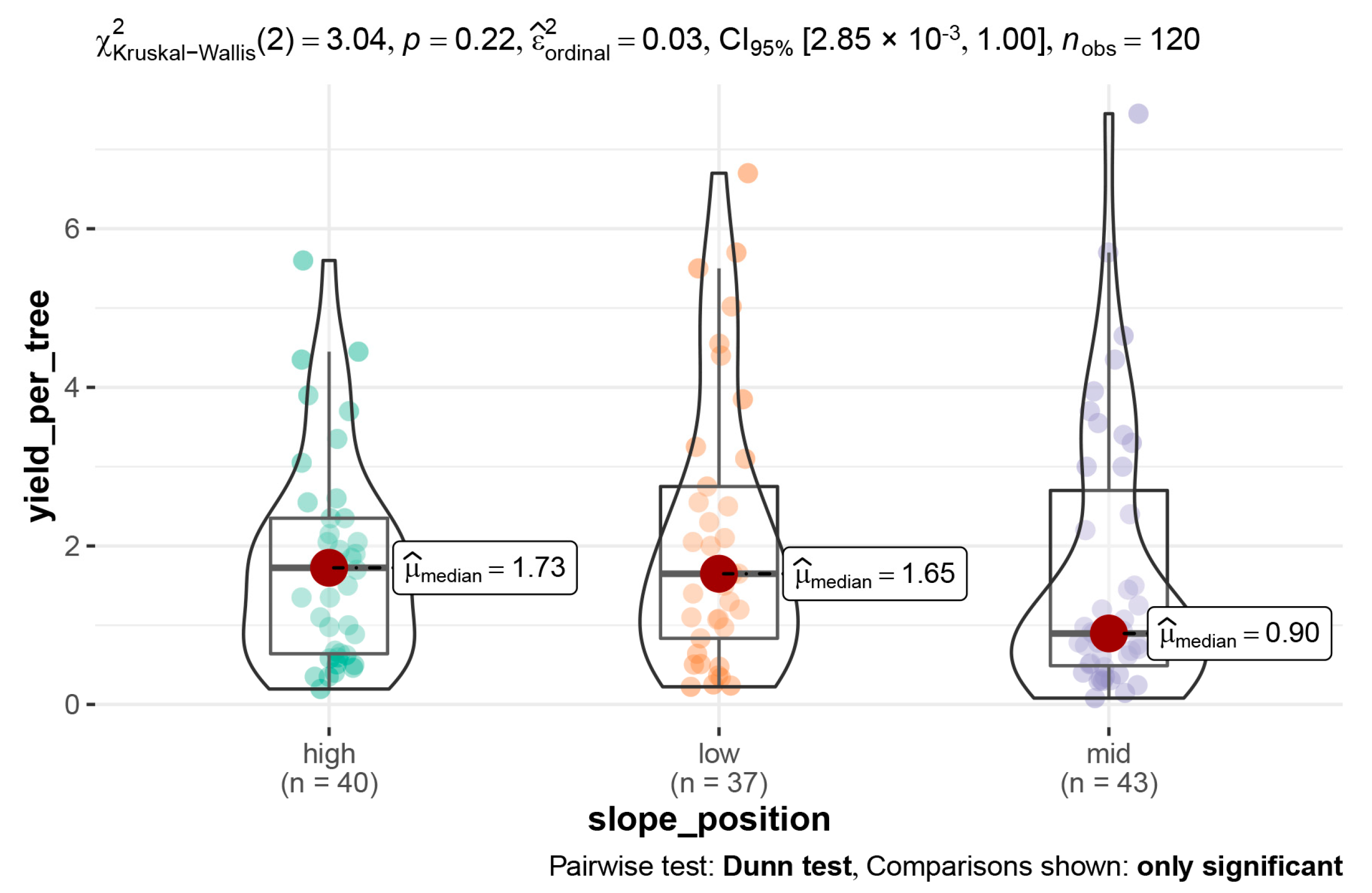

References
- Chen, X.; Chen, X. Variation of fruit size and its frequency distribution in Chinese torreya. Int. J. Fruit Sci. 2020, 20, S1445–S1457. [Google Scholar] [CrossRef]
- Feng, Y.; Hu, Y.; Wu, J.; Chen, J.; Yrjälä, K.; Yu, W. Change in microbial communities, soil enzyme and metabolic activity in a Torreya grandis plantation in response to root rot disease. For. Ecol. Manag. 2019, 432, 932–941. [Google Scholar] [CrossRef]
- Zheng, D.; Ligeng, C.; Pinzhang, T. Genetic variation and fingerprinting of Torreya grandis cultivars detected by ISSR markers. Acta Hortic. Sin. 2008, 35, 1125. [Google Scholar]
- Zhejiang Torreya Industry Association Chinese Torreya. Available online: http://www.china-torreya.com/about.jsp (accessed on 23 August 2021).
- Chen, X.; Jin, H. Review of cultivation and development of Chinese torreya in China. For. Trees Livelihoods 2019, 28, 68–78. [Google Scholar] [CrossRef]
- Wang, Y.; Yao, X.; Yang, L.; Fei, X.; Cao, Y.; Wang, K.; Guo, S. Effects of harvest time on the yield, quality and active substance of Torreya grandis nut and its oil. J. Oleo Sci. 2021, 70, 175–184. [Google Scholar] [CrossRef]
- Han, Y.; Wang, G.G.; Wu, T.; Chen, W.; Ji, Y.; Jin, S. Fertilization Failed to Make Positive Effects on Torreya grandis in Severe N-Deposition Subtropics. Sustainability 2021, 13, 9736. [Google Scholar] [CrossRef]
- Li, R. The Effect of Trace Elements of Torreya grandis Merrillii on Production and Quality. Master’s Thesis, Zhejiang A&F University, Hangzhou, China, 2014. [Google Scholar]
- Shen, J.; Song, L.; Müller, K.; Hu, Y.; Song, Y.; Yu, W.; Wang, H.; Wu, J. Magnesium alleviates adverse effects of lead on growth, photosynthesis, and ultrastructural alterations of Torreya grandis seedlings. Front. Plant Sci. 2016, 7, 1819. [Google Scholar] [CrossRef]
- Zhang, J.; Li, Q.; Wu, J.; Song, X. Effects of nitrogen deposition and biochar amendment on soil respiration in a Torreya grandis orchard. Geoderma 2019, 355, 113918. [Google Scholar] [CrossRef]
- Zhang, R.; Zhao, Y.; Lin, J.; Hu, Y.; Hänninen, H.; Wu, J. Biochar application alleviates unbalanced nutrient uptake caused by N deposition in Torreya grandis trees and seedlings. For. Ecol. Manag. 2019, 432, 319–326. [Google Scholar] [CrossRef]
- Lin, J.; Zhang, R.; Hu, Y.; Song, Y.; Hänninen, H.; Wu, J. Interactive effects of drought and shading on Torreya grandis seedlings: Physiological and growth responses. Trees 2019, 33, 951–961. [Google Scholar] [CrossRef]
- Chen, X.; Niu, J. Evaluating the adaptation of Chinese Torreya plantations to climate change. Atmosphere 2020, 11, 176. [Google Scholar] [CrossRef]
- Gouwakinnou, G.N.; Assogbadjo, A.E.; Lykke, A.M.; Sinsin, B. Phenotypic variations in fruits and selection potential in Sclerocarya birrea subsp. birrea. Sci. Hortic. 2011, 129, 777–783. [Google Scholar] [CrossRef]
- Nyoka, B.; Chanyenga, T.; Mng’omba, S.; Akinnifesi, F.; Sagona, W. Variation in growth and fruit yield of populations of Sclerocarya birrea (A. Rich.) Hochst. Agrofor. Syst. 2015, 89, 397–407. [Google Scholar] [CrossRef]
- Shackleton, C. Growth and fruit production of Sclerocarya birrea in the South African lowveld. Agrofor. Syst. 2002, 55, 175–180. [Google Scholar] [CrossRef]
- Zardo, R.N.; Henriques, R.P.B. Growth and fruit production of the tree Caryocar brasiliense in the Cerrado of central Brazil. Agrofor. Syst. 2011, 82, 15–23. [Google Scholar] [CrossRef]
- Xie, Z.; Chu, K.; Han, G.; Guo, W. Nut Yield Model for Ancient Torreya grandis cv. Merrillii. J. Zhejiang For. Sci. Technol. 2017, 37, 79–86. [Google Scholar]
- Tong, C.; Zhang, X.; Xie, J.; Mei, T.; Fang, D.; Li, Y. Water use strategies of different aged moso bamboo culms under summer drought. For. Ecol. Manag. 2021, 498, 119567. [Google Scholar] [CrossRef]
- Liu, Q.; Zhou, Z.; Fan, H.; Liu, Y. Genetic variation and correlation among resin yield, growth, and morphologic traits of Pinus massoniana. Silvae Genet. 2013, 62, 38–43. [Google Scholar] [CrossRef]
- Kramer, P.J. The role of physiology in forestry. Tree Physiol. 1986, 2, 1–16. [Google Scholar] [CrossRef]
- Primack, R.B. Relationships among flowers, fruits, and seeds. Annu. Rev. Ecol. Syst. 1987, 18, 409–430. [Google Scholar] [CrossRef]
- Kelly, D. The evolutionary ecology of mast seeding. Trends Ecol. Evol. 1994, 9, 465–470. [Google Scholar] [CrossRef]
- Moles, A.T.; Ackerly, D.D.; Webb, C.O.; Tweddle, J.C.; Dickie, J.B.; Pitman, A.J.; Westoby, M. Factors that shape seed mass evolution. Proc. Natl. Acad. Sci. USA 2005, 102, 10540–10544. [Google Scholar] [CrossRef]
- Rees, M.; Venable, D.L. Why do big plants make big seeds? J. Ecol. 2007, 95, 926–936. [Google Scholar] [CrossRef]
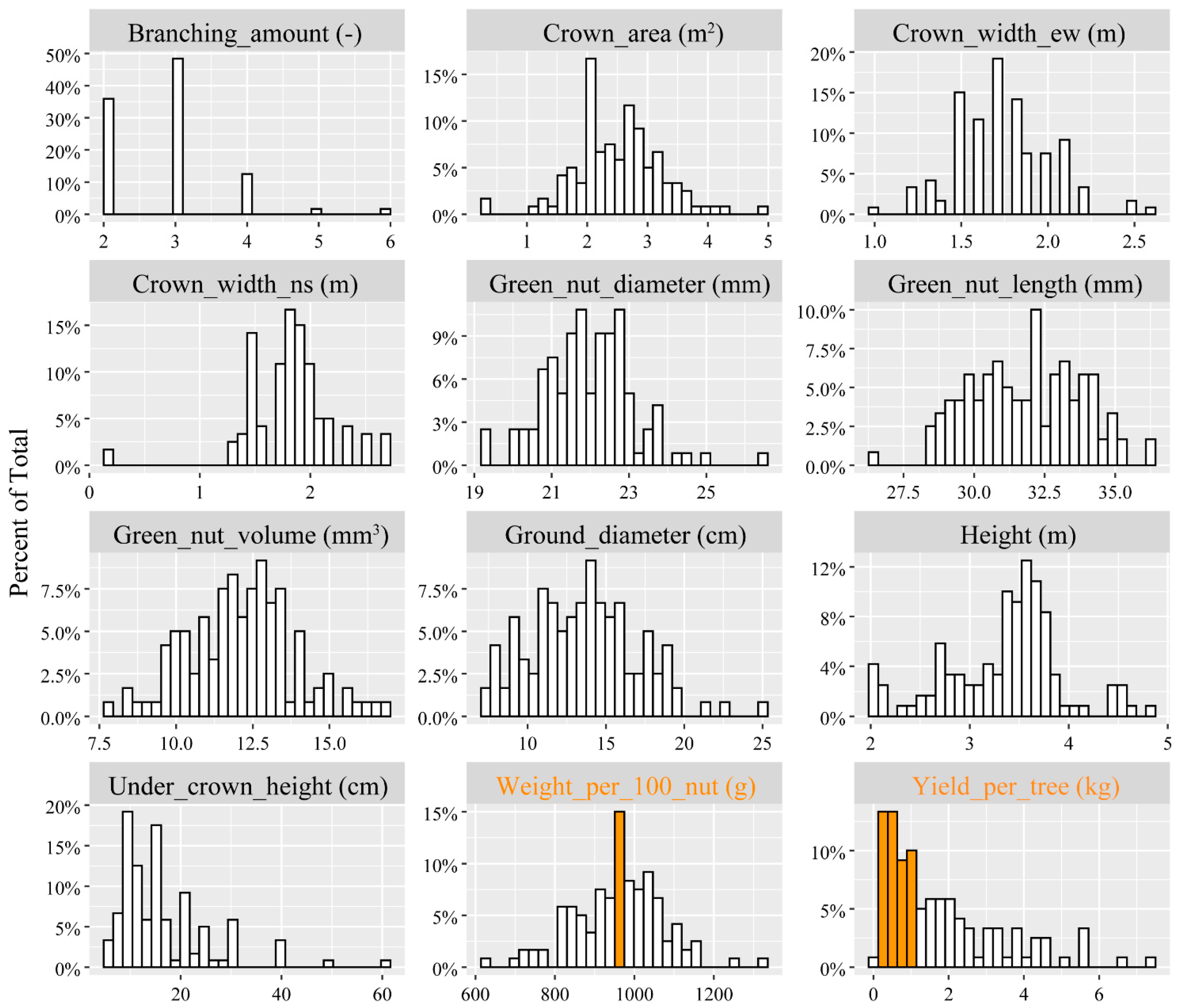
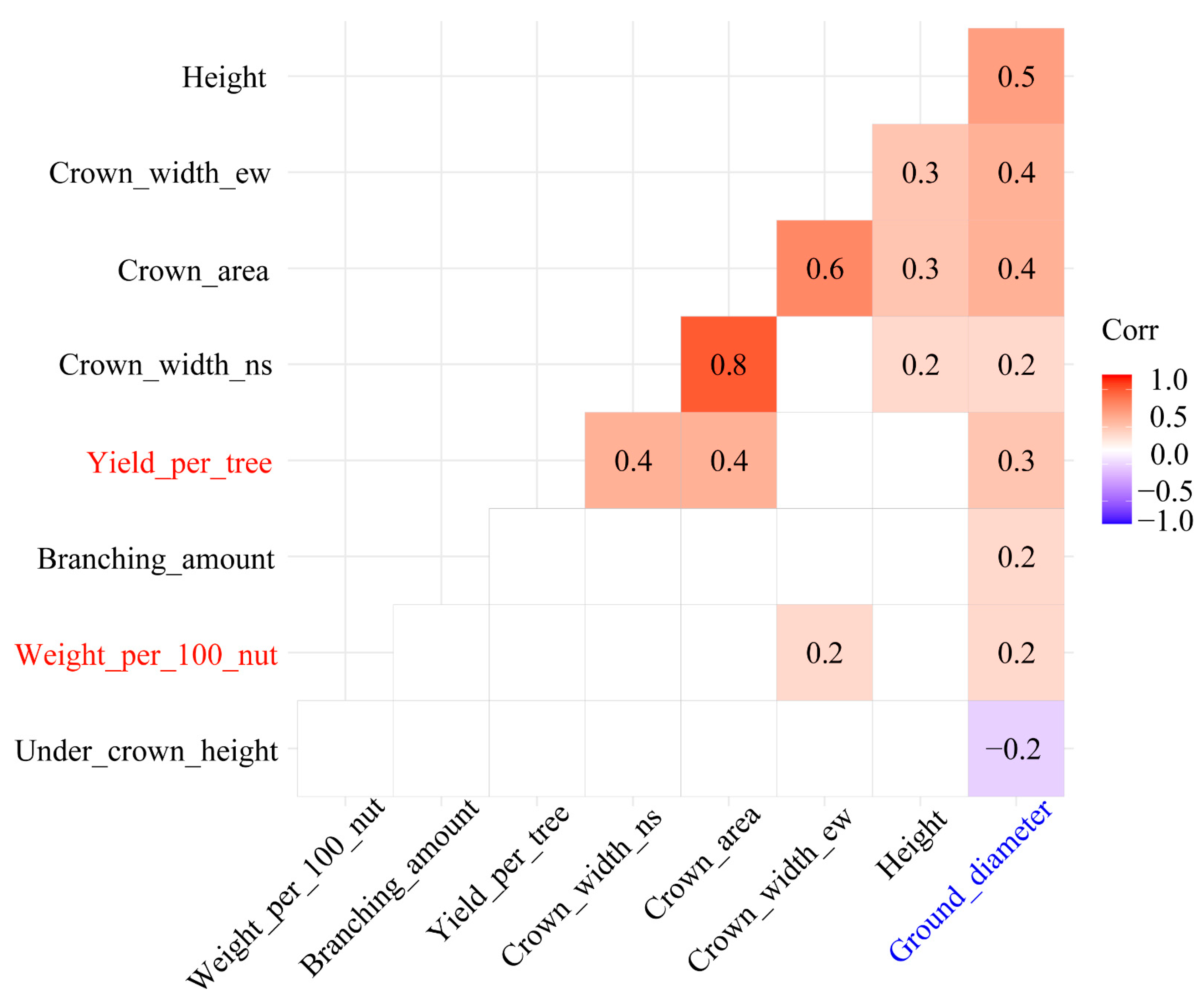
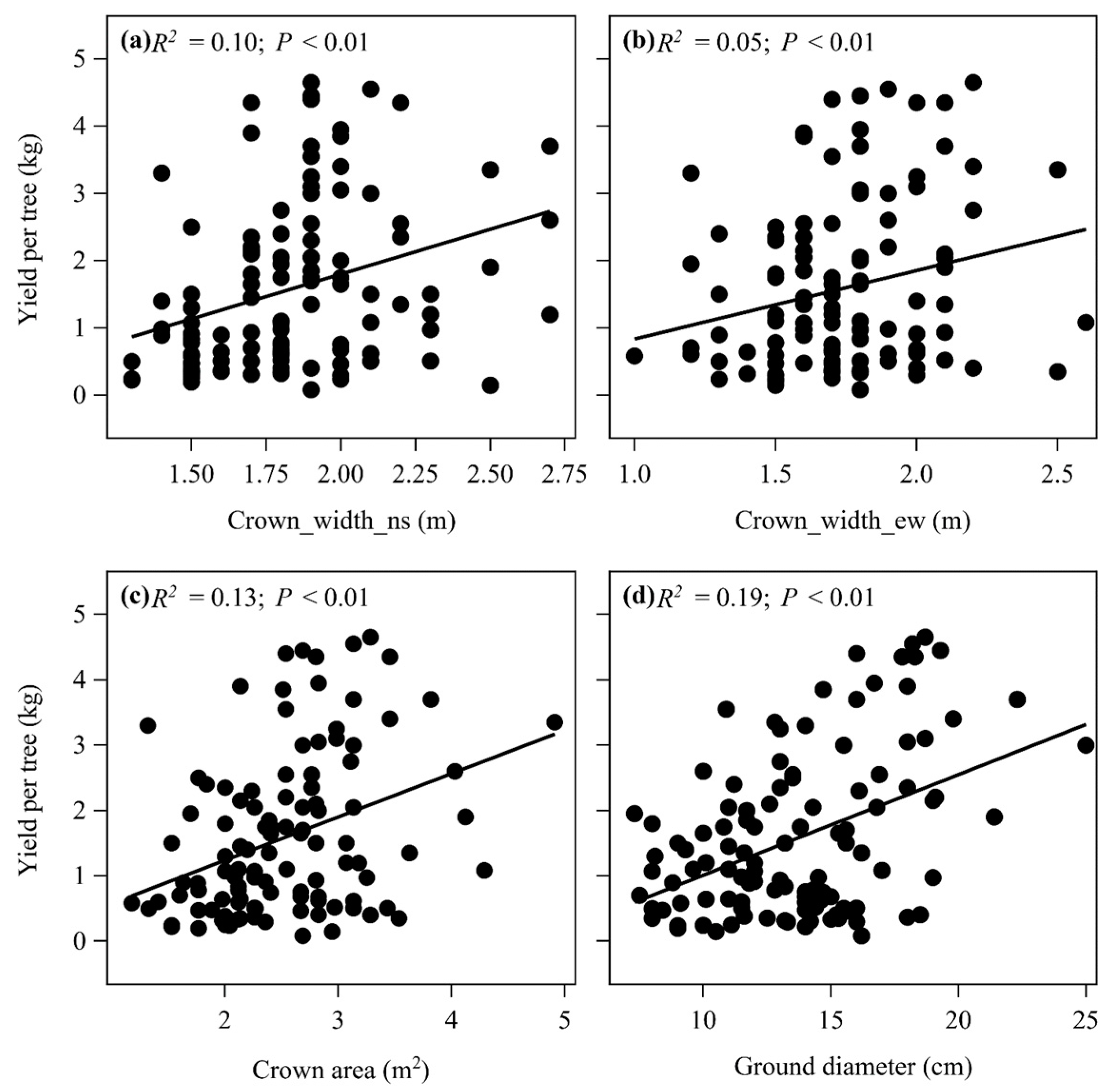
| Statistics | Tree Height/m | Ground Diameter/cm | Crown Area/m2 | Under-Crown Height /cm | Branching Amount | Weight_per_100_nuts /kg | Green Nut Volume/cm3 | Yield per Tree/kg |
|---|---|---|---|---|---|---|---|---|
| Mean ± std | 3.4 ± 0.6 | 13.6 ± 3.4 | 3.3 ± 0.8 | 16.7 ± 9.1 | 2.9 ± 0.8 | 1.0 ± 0.1 | 12.3 ± 1.9 | 1.8 ± 1.6 |
| Range | 2.0–4.8 | 7.3–25.0 | 1.5–6.3 | 5–60 | 2–6 | 0.6–1.3 | 7.9–21.0 | 0.1–7.5 |
| CV (%) | 17.8 | 25.2 | 25.8 | 54.4 | 29.0 | 11.6 | 15.4 | 86.7 |
| ProbF | Model R-Square | Variable Entered | Parameter Estimate | Partial R-Square | var_Explained |
|---|---|---|---|---|---|
| <0.01 | 0.29 | ground_diameter | 0.18 | 0.19 | 64.4% |
| under_crown_height | 0.03 | 0.06 | 21.5% | ||
| crown_width_NS | 0.83 | 0.03 | 8.61% | ||
| height | −0.30 | 0.02 | 5.47% |
| ProbF | Model R-Square | Variable | Estimate | Pr > |t| |
|---|---|---|---|---|
| <0.01 | 0.32 | ground_diameter | 0.19 | <0.01 |
| under_crown_height | 0.03 | 0.02 | ||
| height | −0.36 | 0.07 | ||
| branching_amount | −0.19 | 0.15 | ||
| crown_area | 1.94 | 0.20 | ||
| crown_width_EW | −2.78 | 0.21 | ||
| crown_width_NS | −1.76 | 0.40 |
Disclaimer/Publisher’s Note: The statements, opinions and data contained in all publications are solely those of the individual author(s) and contributor(s) and not of MDPI and/or the editor(s). MDPI and/or the editor(s) disclaim responsibility for any injury to people or property resulting from any ideas, methods, instructions or products referred to in the content. |
© 2023 by the authors. Licensee MDPI, Basel, Switzerland. This article is an open access article distributed under the terms and conditions of the Creative Commons Attribution (CC BY) license (https://creativecommons.org/licenses/by/4.0/).
Share and Cite
Chen, X.; Bai, S.; Fang, D. How Do Morphological Factors Influence the Green Nut Yield of Chinese Torreya? Horticulturae 2023, 9, 202. https://doi.org/10.3390/horticulturae9020202
Chen X, Bai S, Fang D. How Do Morphological Factors Influence the Green Nut Yield of Chinese Torreya? Horticulturae. 2023; 9(2):202. https://doi.org/10.3390/horticulturae9020202
Chicago/Turabian StyleChen, Xi, Shangbin Bai, and Dongming Fang. 2023. "How Do Morphological Factors Influence the Green Nut Yield of Chinese Torreya?" Horticulturae 9, no. 2: 202. https://doi.org/10.3390/horticulturae9020202
APA StyleChen, X., Bai, S., & Fang, D. (2023). How Do Morphological Factors Influence the Green Nut Yield of Chinese Torreya? Horticulturae, 9(2), 202. https://doi.org/10.3390/horticulturae9020202





